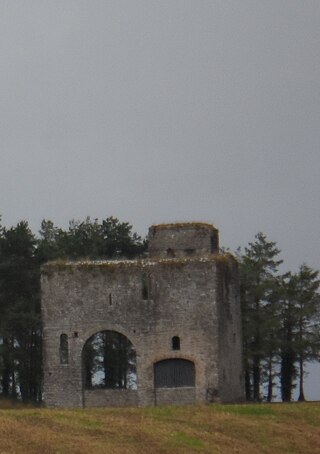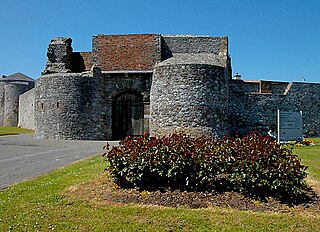James Butler, 1st Earl of Ormond, was a noble in the Peerage of Ireland. He was born in Arklow, Wicklow, Ireland and died in Gowran, Kilkenny, Ireland.
Sir Richard de Exeter was an Anglo-Norman knight and baron who served as a judge in Ireland.
John FitzThomas was an Anglo-Norman in the Peerage of Ireland, as 4th Lord of Offaly from 1287 and subsequently as 1st Earl of Kildare from 1316.
Joan Butler, Countess of Carrick was an Irish noblewoman, and the wife of Edmund Butler, Earl of Carrick, Justiciar of Ireland. She was the mother of James Butler, 1st Earl of Ormond.
Elizabeth Butler, Countess of Ormond, was the wife of Irish peer James Butler, 2nd Earl of Ormond, and the mother of his six children, including James Butler, 3rd Earl of Ormond.
Edmund Butler, 6th Chief Butler of Ireland and nominally Earl of Carrick, was an Irish magnate who served as Justiciar of Ireland during the difficult times of the Scottish invasion from 1315 to 1318 and the great famine of 1316 to 1317.

Richard Wogan was an Irish judge and cleric who held the office of Lord Chancellor of Ireland, and also served as a soldier.
Richard de Beresford or Bereford was an English-born cleric and judge who held high political office in Ireland in the early fourteenth century as Lord High Treasurer of Ireland and Lord Chancellor of Ireland.

Sir John Wogan or John de Wogan, styled lord of Picton was a Cambro-Norman judge who served as Justiciar of Ireland from 1295 to 1313. There are several dubious theories about Wogan's ancestry, and uncertainty exists about his wives, sons, and other relations. He came from Picton in Pembrokeshire and was a vassal of William de Valence, 1st Earl of Pembroke. He came to have lands in Pembrokeshire, Somerset, Dorset, Devon, Wiltshire, and Oxfordshire. He may have represented de Valence at an Irish court case in 1275, and in 1280 he was steward of Wexford, Valence's Irish liberty. He was a justice in eyre in England in 1281–4, and returned to Ireland in 1285. In 1290 he was a referee with Hugh Cressingham in a dispute between Queen Eleanor and de Valence and his wife. He was on eyre again in the mid-1290s, sitting in the North of England.
Sir Robert Bagod was an Irish judge who was appointed the first Chief Justice of the Irish Common Pleas in 1276. He built Baggotrath Castle, which was the strongest fortress in Dublin: it was located on present-day Baggot Street in central Dublin. He also founded the Carmelite Friary in Dublin.
Nicholas Fastolf was an English-born judge who was a leading member of the early Irish judiciary; according to the most reliable source, he was the first judge to hold the office of Lord Chief Justice of Ireland. He was probably the direct ancestor of Sir John Fastolf, who is generally thought to have inspired Shakespeare's character Falstaff.
John de Grauntsete or Grantsete (or John of Grantchester) (c. 1270 – c. 1350) was an English judge who lived in fourteenth-century Ireland. We know more about him than we do about any other contemporary Irish judge, and from the surviving information we can form some idea of the lifestyle of an Irish judge in his time. He sat in turn in each of the Irish Courts of common law, and uniquely he is known to have appeared in Court as an advocate even after he became a judge.
John de Ponz, also called John de Ponte, John Savan, or John of Bridgwater (c.1248–1307) was an English-born administrator, lawyer and judge in the reign of King Edward I. He served in the Royal Household in England for several years before moving to Ireland, where he practised in the Royal Courts as the King's Serjeant-at-law (Ireland). He later served as a justice in eyre, and then as a justice of the Court of Common Pleas (Ireland). He was a gifted lawyer, but as a judge was accused of acting unjustly. A case he heard in Kilkenny in 1302 can be seen as a precursor of the Kilkenny Witchcraft Trials of 1324, and involved several of the main actors in the Trials.
Walter de Cusack was an Anglo-Irish judge, magnate and military commander of the fourteenth century.
Hugh Canoun, or Hugh Canon was an English-born judge in early fourteenth-century Ireland. He was a justice of the Court of Common Pleas (Ireland) and served as Deputy Justiciar of Ireland. As a judge he was praised for his good and faithful service to the English Crown, and as a lawyer he was known as "a man very knowledgeable about all the King's business". On the other hand, his loyalty to the Crown during the Scottish Invasion of Ireland in 1315-18 was said to be extremely doubtful, although he was saved from disgrace by his influential connections. He was murdered by Andrew de Bermingham of Athenry in 1317/18, during the last months of the Bruce Invasion, in the course of a private feud, of which little is known.

Sir Walter de la Haye, or de Haye was an English-born statesman and judge in Ireland of the late thirteenth and early fourteenth centuries, who served for many years as Sheriff of County Waterford and as Chief Escheator of Ireland, and briefly as Justiciar of Ireland.
Simon de Ludgate was an English-born judge in Ireland in the reign of King Edward I of England, who held office as Chief Justice of the Common Pleas for Ireland.
William Alysaundre or Alesander was an Irish judge and Crown official in the reigns of King Edward I of England and his son Edward II.

Sir John de Fressingfield (c.1260-c.1323) was an English knight, judge, diplomat and Privy Councillor, much of whose career was spent in Ireland. Though he is almost entirely forgotten now, he was a figure of some importance in English and Irish public life in the first 20 years of the fourteenth century. He also held judicial office in Jersey and Guernsey.

Waleran de Wellesley was a judge, statesman and landowner in thirteenth century Ireland. He was a member of the Privy Council of Ireland. He was the ancestor of the Duke of Wellington, and was the first of the de Wellesley family to settle in Ireland.